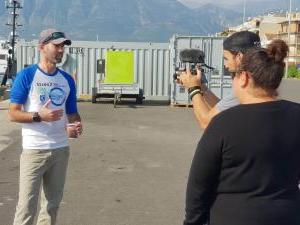
1. WHAT WAS YOUR MAJOR AND GRADUATION YEAR?
I graduated from the GEBCO program in 2014 with an Advanced Ocean Mapping Certificate. It is a unique program aimed at international students, and it's probably the best of its kind.
2. WHAT IS YOUR FAVORITE UNH MEMORY?
As a grad student at UNH, I really enjoyed the Campus Recreation Outdoor Adventures. It was the best way to explore all the wonders of New Hampshire in small guided groups through all seasons. I joined so many trips with them, I think I was their best client that year! Another great memory were the special lab visits within the GEBCO program. That gave me great fieldwork experience and some awesome adventures around the world.
3. WAS THERE A PROFESSOR OR STAFF MEMBER WHO POSITIVELY IMPACTED YOU? HOW DID HE/SHE CONTRIBUTE TO YOUR EXPERIENCE AT UNH?
The level and quality of academic teaching at UNH is among the highest I've experienced in my education. I've learned so much from so many people in my department, CCOM. Many of the researchers remain colleagues and collaborators of mine to this day. I also learned a lot from my classmates that year; working together and solving problems as an international group is a great force multiplier.
4. WHAT ARE YOU DOING NOW? HOW DID YOUR DEGREE PROGRAM AT UNH HELP YOU PREPARE FOR YOUR CAREER?
Nowadays, I actually work at UNH for the same department I graduated from. I've kept in touch with several researchers and was offered a full-time position on an exciting new international project called Seabed 2030, and we're contributing to mapping the entire ocean floor together with other research institutes around the world. I'm also a part of the Multibeam Advisory Committee, which is funded by the National Science Foundation to make sure that the seafloor mapping capabilities of the U.S. academic fleet are realized to their full potential.
5. WHO IS YOUR ROLE MODEL AND WHY?
Professionally, one of my greatest role models is Marie Tharp, who was able to create the first global map of the ocean floor from the very little data they had back then, but still so detailed and informative enough to actually predict and support the plate tectonics paradigm, which was needed so much to explain so many different phenomena on Earth. Nowadays, we have infinitely more data and computing power at our disposal, but I think we could all learn from her innovative and forward thinking approach.
